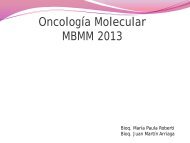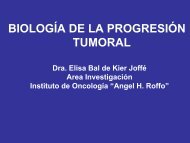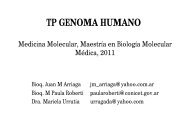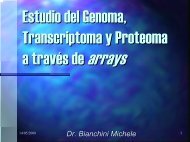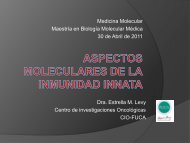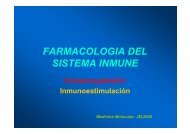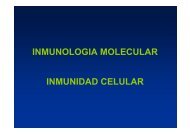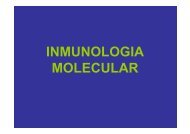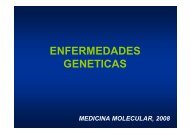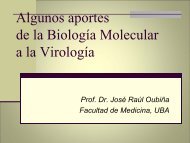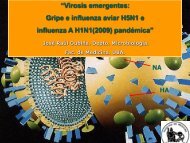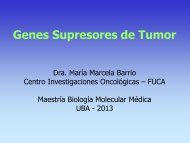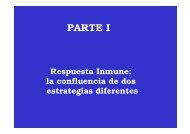ENFERMEDADES GENETICAS - José Mordoh
ENFERMEDADES GENETICAS - José Mordoh
ENFERMEDADES GENETICAS - José Mordoh
Create successful ePaper yourself
Turn your PDF publications into a flip-book with our unique Google optimized e-Paper software.
<strong>ENFERMEDADES</strong><br />
<strong>GENETICAS</strong><br />
MEDICINA MOLECULAR, 2009
METAFASE DE UN LINFOCITO DE SANGRE PERIFERICA. DAPI
Cariotipo normal
Mechanisms of Gene Expression<br />
1) X chromosome inactivation (Lyonization)<br />
2) Genomic Imprinting<br />
3) RNA Splicing<br />
4) Photocopy (Transcriptional) Regulation<br />
4.a) Methylation<br />
4.b) Transcription Factors<br />
5) Packaging (Post-Translational) Regulation
RNA Splicing<br />
RNA transcript before editing:<br />
exon 1 intron 1 exon 2 intron 2 exon 3 intron 3 exon 4 intron 4 exon 5<br />
exon 1 exon 2 exon 3 exon 4<br />
exon 1 exon 2 exon 3 exon 5<br />
mRNA after editing:<br />
mRNA after editing:<br />
Polypeptide 1 Polypeptide 2
REGULACION DE LA EXPRESION GENICA<br />
POR METILACION (CpG)<br />
INACTIVACION DEL CROMOSOMA X = LIONIZACION<br />
GENES ACTIVOS = METILACION <br />
GENES INACTIVOS=<br />
METILACION
Transcriptional Regulation:<br />
I: Methylation<br />
• Methyl group (CH 3 ) added to DNA<br />
• Shuts off genes (prevents transcription)<br />
• Tissue specific (e.g., genes methylated in the<br />
MHC differ in different tissues)<br />
•Human Epigenome Project (map the<br />
methylated DNA areas in the human genome)
Cromosoma X. 1336 genes. Uno de ambos X<br />
se inactiva por metilación en el día 16 (al azar).<br />
Las mujeres son mosaicos.
X Chromosome Inactivation<br />
(Lyonization)<br />
•At fertilization, both X chromosomes are active.<br />
•Very soon, however, one of the X chromosomes in a cell,<br />
apparently taken at random, is inactivated and forms a Barr<br />
body.<br />
•All other cells derived from the initial cell have the SAME X<br />
chromosome inactivated.<br />
•Genes on the inactive X chromosome are not expressed.<br />
•In humans, though, a few genes are expressed.
Barr Bodies
X X<br />
X<br />
X<br />
X<br />
X<br />
X<br />
X<br />
Black<br />
Fur<br />
Orange<br />
Fur
Mechanism<br />
•XIST gene on the X chromosome turns on<br />
and produces XIST RNA.<br />
•Molecules of XIST RNA accumulate along<br />
the chromosome with the active XIST gene.<br />
•The binding of the XIST RNA with the DNA<br />
turns off the genes on that chromosome.
Y-chromosome genes
X and Y chromosomes at<br />
meiosis
Methods of Prenatal Genetic<br />
Testing<br />
• Amniocentesis<br />
• CVS<br />
• Ultrasound<br />
• Maternal serum screening (Labcorp, 2006)<br />
• Four Methods of testing<br />
– Cytogenic testing: analysis of the number and<br />
shape of chromosomes<br />
– Fluorescence in situ hybridization: protein<br />
analysis/chromosomal arrangements and study<br />
of protein markers<br />
– Biochemical testing: protein and enzyme<br />
analysis of the blood<br />
– Indirect/direct analysis of DNA strands (Carrier<br />
screening)<br />
• (Labcorp, 2006)
A diagram of technique of transvaginal chorionic villus<br />
sampling
A diagram of technique of amniocentesis
MOSAICISMO PLACENTARIO<br />
CONFINADO<br />
• 1-2 % DE LOS CASOS<br />
• GENERALMENTE TRISOMIAS<br />
(21,13,18)<br />
• 90 % CONFINADO A LA PLACENTA<br />
• REQUIERE CONFIRMACION POR<br />
AMNIOCENTESIS<br />
• ECOGRAFIA ES MUY UTIL
• Further more it is vital that we, as health<br />
care professionals, along with prospective<br />
parents, are mindful that one genetic<br />
mutation is only a characteristic of the<br />
child. It does not define them entirely.<br />
(Asch, 1999)
Human Populations<br />
All individuals share<br />
genome sequences<br />
which are 99.9%<br />
identical.<br />
The remaining 0.1% is<br />
responsible for all of the<br />
genetic diversity<br />
between individuals.<br />
Typing SNPs allows us to<br />
chart the evolution of the<br />
human race and its<br />
migration across the<br />
globe.
DEFINICIONES<br />
• LOCUS: Segmento de DNA heredado de forma<br />
Mendeliana<br />
• GENOTIPO: Información contenida en un locus<br />
• ALELOS: Diferencias normales en el genotipo para un<br />
gene determinado<br />
• HOMOCIGOTA: Alelos idénticos<br />
• HETEROCIGOTA: Alelos diferentes<br />
• FENOTIPO: Características visibles de un individuo<br />
• DOMINANTE: Alelo heterocigota reconocido en el<br />
fenotipo<br />
• RECESIVO: Alelo heterocigota no reconocido en el<br />
fenotipo<br />
• CODOMINANTE: Ambos alelos son co-expresados
SNPs are Very Common<br />
• SNPs are very common in the human<br />
population.<br />
• Between any two people, there is an<br />
average of one SNP every ~1250 bases.<br />
• Most of these have no phenotypic effect<br />
– Venter et al. estimate that only
RFLP<br />
(Restriction Fragment Length<br />
Polymorphisms)
Genome Sequencing finds<br />
SNPS<br />
• The Human Genome Project involves<br />
sequencing DNA cloned from a number of<br />
different people.<br />
[The Celera sequence comes from 5 people]<br />
• Even in a library made from one person’s<br />
DNA, the homologous chromosomes have<br />
SNPs<br />
• This inevitably leads to the discovery of SNPs<br />
- any single base sequence difference<br />
• These SNPs can be valuable as the basis for<br />
diagnostic tests
<strong>ENFERMEDADES</strong> <strong>GENETICAS</strong> (3-5%)<br />
• Trastornos cromosómicos<br />
• Trastornos mendelianos o monogénicos<br />
• Enfermedades multifactoriales<br />
• Formas no-clásicas de enfermedad genética<br />
(imprinting genómico, etc)<br />
• Trastornos mitocondriales<br />
• Mutaciones que surgen en células somáticas<br />
diferenciadas
Meiosis<br />
Cell division – ‘reduction<br />
division’<br />
Production of sex cells – gametes<br />
Meiosis errors
Meiosis<br />
Parent cell –<br />
chromosome pair<br />
Chromosomes<br />
copied<br />
1 st division - pairs split<br />
2 nd division – produces<br />
4 gamete cells with ½<br />
the original no. of<br />
chromosomes
Meiosis – mouse testes<br />
Parent cell<br />
1 st division<br />
2 nd division<br />
4 gametes
Nondisjunction of X chromosome<br />
Nondisjunction also occurs with autosomes
Trisomy:<br />
Down Syndrome (47, +21)<br />
• Characteristic facial patterning, mental retardation<br />
• 1 / 800 live births
Down syndrome—maternal age<br />
effect
Other trisomies:<br />
Patau Syndrome (47, +13)<br />
• 1 / 19,000 live births
Frequent Chromosome Abnormalities<br />
Disorder Chromosomal Genotype Frequency<br />
Abnormal no. of chromosome sets<br />
Triploidy 69XX, 69XY Frequent in miscarriage<br />
Tetraploidy 92XX, 92XY Frequent in miscarriage<br />
Abnormal no. of autosomes<br />
Trisomy 21 1/600<br />
Trisomy 18 1/5000<br />
Trisomy 13 1/15.000<br />
Abnormal no. of sex crhomosomes<br />
Klinefelter syndrome 47XXY 1/1000 males<br />
XYY-syndrome 47XYY 1/1000<br />
Turner syndrome 45X0,45X/46X0,45X/46XY 1/10.000 females<br />
(mosaicism)<br />
Triple-X syndrome XXX 1/1000
Principles of Molecular Medicine, 1998
48,XXXY
Turner syndrome<br />
• 1/5,000 females<br />
• Gonadal dysgenesis, disappearance of eggs<br />
• Sexual immaturity<br />
– Amenorrhea<br />
– Infertility<br />
• Short stature<br />
• Somatic abnormalities<br />
• Something wrong with the second X in some<br />
cells
SINDROMES KLINEFELTER Y TURNER
Turner<br />
syndrome
EXAMPLES OF DIFFERENT TYPES OF MUTATIONS<br />
Type of mutations<br />
Example<br />
Genome<br />
Abnormal Chromosome set<br />
Chromosome<br />
Triploidy, tetraploidy<br />
Abnormal number of autosomal chrom. Trisomy 21, 18, 13<br />
Abnormal number of sex chromosomes<br />
Klinefelter and Turner syndrome<br />
Translocation Acute myeloid leukemia t (9;22)<br />
(q34:q11) “Philadelphia chromosome”<br />
Deletion Cri du chat syndrome 5p-<br />
Gene<br />
Deletion<br />
Duplication, insertion<br />
Triplet expansion<br />
Missense point mutation<br />
Splicing mutation<br />
Duchenne muscular dystrophy.<br />
Thalassemia<br />
Charcot-Marie-Tooth Type I<br />
Fragile X syndr., Huntington disease<br />
Cystic fibrosis<br />
Globin
Mutations<br />
A change in the DNA sequence of the<br />
gene<br />
All cells acquire mutations as they<br />
divide<br />
rate of approx 10 -6 per gene per cell<br />
Mutations can alter protein product of<br />
DNA, stop gene working or activate<br />
gene
Types of Mutation<br />
• Deletion - DNA missing<br />
• Insertion - extra DNA inserted<br />
• Expansion - DNA repeat size has<br />
increased<br />
• Point Mutation - change in one<br />
base
Types of Mutation (in coding<br />
sequence)<br />
AGC TTC GAC CCG<br />
AGC TCG ACC CG<br />
AGC TTC CGA CCC G<br />
Wild type<br />
Deletion<br />
Insertion<br />
AGC TTC TTC GAC CCG Expansion<br />
ATC TTC GAC CGG<br />
ATC TGA<br />
Point<br />
mutation<br />
Nonsense<br />
‘stop’
PENETRANCIA<br />
Está definida por la edad y<br />
frecuencia con que se<br />
expresa una mutación<br />
determinada
<strong>ENFERMEDADES</strong> <strong>GENETICAS</strong><br />
• Trastornos cromosómicos<br />
• Trastornos mendelianos ó monogénicos<br />
• Enfermedades multifactoriales<br />
• Formas no clásicas (imprinting genómico)<br />
• Trastornos mitocondriales<br />
• Mutaciones en células somáticas<br />
diferenciadas
Selected Monogenic Disorders<br />
Autosomal dominant disorders<br />
Familial hyperlipidemia<br />
Familial hypercholesterolemia<br />
Autosomal recessive disorders<br />
Cystic fibrosis<br />
Sickle-cell anemia<br />
-Thalassemia<br />
1-antitrypsin deficiency<br />
Hereditary nonpolyposis colon cancer<br />
X-linked disorders<br />
Color blindness<br />
Hemophilia A<br />
Hemophilia B<br />
Huntington disease<br />
von Willebrand disease<br />
Phenylketonuria<br />
Hemochromatosis<br />
Tay-Sachs disease<br />
Polyposis of the colon<br />
Familial breast cancer<br />
Duchenne muscular dystrophy<br />
Becker muscular dystrophy<br />
Fragile X syndrome
Cystic fibrosis<br />
transmembrane regulator<br />
(CFTR)
Destrucción del tejido<br />
pulmonar en Fibrosis<br />
Quística
<strong>ENFERMEDADES</strong> <strong>GENETICAS</strong><br />
• Trastornos cromosómicos<br />
• Trastornos mendelianos ó monogénicos<br />
• Enfermedades multifactoriales<br />
• Formas no clásicas (imprinting genómico)<br />
• Trastornos mitocondriales<br />
• Mutaciones en células somáticas<br />
diferenciadas
<strong>ENFERMEDADES</strong><br />
MULTIFACTORIALES O RASGOS<br />
GENETICOS COMPLEJOS<br />
ASMA<br />
ARTRITIS REUMATOIDE<br />
DIABETES MELLITUS<br />
ESQUIZOFRENIA<br />
HIPERTENSION
DESVIACIONES DE LEYES<br />
MENDEL<br />
• PENETRANCIA / NO PENETRANCIA<br />
• MUTACIONES NUEVAS<br />
• MOSAICISMO<br />
• ANTICIPACION<br />
• IMPRINTING<br />
• HERENCIA DIGENICA
SINDROME DE RETARDO<br />
MENTAL POR X FRAGIL
Principles of Molecular Medicine, 1998
Triplet Repeat Diseases
Fragile X syndrome
Principles of Molecular Medicine, 1998
<strong>ENFERMEDADES</strong> <strong>GENETICAS</strong><br />
• Trastornos cromosómicos<br />
• Trastornos mendelianos ó monogénicos<br />
• Enfermedades multifactoriales<br />
• Formas no clásicas (imprinting genómico)<br />
• Trastornos mitocondriales<br />
• Mutaciones en células somáticas<br />
diferenciadas
Genomic Imprinting<br />
• Some genes are turned off when inherited<br />
from the father and turned on when inherited<br />
from the mother.<br />
• Other genes are turned on when inherited<br />
from father but turned off when inherited from<br />
mother.<br />
• Mechanisms: methylation; phosphorylation of<br />
histones.
SINDROME DE PRADER-WILLI<br />
Hiperfagia,Hipotonia,<br />
Hipogonadismo, Obesidad<br />
SINDROME DE ANGELMANS<br />
“Sindrome de Happy Puppet”
Principles of Molecular Medicine, 1998
Principles of Molecular Medicine, 1998
<strong>ENFERMEDADES</strong> <strong>GENETICAS</strong><br />
• Trastornos cromosómicos<br />
• Trastornos mendelianos ó monogénicos<br />
• Enfermedades multifactoriales<br />
• Formas no clásicas (imprinting genómico)<br />
• Trastornos mitocondriales<br />
• Mutaciones en células somáticas<br />
diferenciadas
Principles of Molecular Medicine, 1998
Principles of Molecular Medicine, 1998
Principles of Molecular Medicine, 1998
Principles of Molecular Medicine, 1998
<strong>ENFERMEDADES</strong> <strong>GENETICAS</strong><br />
• Trastornos cromosómicos<br />
• Trastornos mendelianos o monogénicos<br />
• Enfermedades multifactoriales<br />
• Formas no-clásicas de enfermedad genética<br />
(imprinting genómico, etc)<br />
• Trastornos mitocondriales<br />
• Mutaciones que surgen en celulas somaticas<br />
diferenciadas
La Terapia Génica
TERAPIAS GENICAS<br />
INMUNODEF.<br />
PRIMARIAS<br />
NEOPLASIAS<br />
TERAPIA GENICA<br />
INMUNODEF.<br />
SECUNDARIAS<br />
<strong>ENFERMEDADES</strong><br />
AUTOINMUNES
CLASIFICACION DE LA TERAPIA GENICA<br />
De acuerdo a la<br />
estrategia empleada<br />
De acuerdo al sitio y la<br />
forma en la que se<br />
realiza<br />
• Corrección<br />
• Adición<br />
• Terapia Génica “in vivo”<br />
• Terapia Génica “ex vivo”
VENTAJAS Y DESVENTAJAS DE VECTORES UTILIZADOS PARA<br />
TERAPIA GENICA<br />
VECTOR VENTAJAS DESVENTAJAS<br />
RETROVIRAL<br />
Amplio rango de tropismo por<br />
las células target. Eficiencia<br />
en la transferencia. Se inserta<br />
en el cromosoma de la célula<br />
huésped asegurando<br />
estabilidad en el tiempo y un<br />
alto nivel de expresión del<br />
gen terapéutico.<br />
ADENOVIRAL Mayor capacidad para<br />
insertar genes terapéuticos.<br />
Infecta células que no se<br />
hallan en división.<br />
VIRAL<br />
ADENO-ASOCIADO<br />
LIPOSOMAS<br />
NO VIRALES<br />
PLASMIDOS Y<br />
DNA DESNUDO<br />
No inmunogénico<br />
Se inserta en un sitio<br />
específico del genoma<br />
No replicativos<br />
No inmunogénicos<br />
No replicativos<br />
No inmunogénicos<br />
Infecta sólo células en<br />
división.<br />
Riesgos de replicación<br />
Riesgos de mutagénesis<br />
insercional en su<br />
inserción aleatoria<br />
Inmunogénico.<br />
Riesgos de replicación.<br />
Poco estables por la falta<br />
de integración.<br />
Muy baja capacidad para<br />
insertar el gen terapéutico<br />
Baja eficiencia en la<br />
transferencia de genes<br />
Baja eficiencia en la<br />
transferencia de genes<br />
Inestabilidad marcada
Sistema de transferencia de genes terapéuticos<br />
In vivo<br />
Transferencia directa al huésped<br />
Vectores virales<br />
• Adenovirus<br />
•Retrovirus<br />
•Virus asociado a adeno<br />
• Herpes simplex<br />
• Pox virus<br />
Métodos no virales<br />
• DNA-liposomas<br />
• DNA desnudo<br />
• Ligando-receptor<br />
Ex vivo<br />
Transferencia mediante el uso de células<br />
modificadas genéticamente<br />
Vectores virales<br />
• Adenovirus<br />
•Retrovirus<br />
•Virus asociado a adeno<br />
Métodos no virales<br />
• Fosfato de calcio<br />
• Electroporación<br />
• Bombeo de partículas
Maestría en Biología<br />
Molecular Médica –<br />
Dr. José <strong>Mordoh</strong> 2002
CONDICIONANTES DEL ÉXITO<br />
DE LA TG<br />
EXITO<br />
• Si las células “corregidas” tienen ventajas<br />
selectivas sobre las “no corregidas” =<br />
(ejemplo : ADA, adenosine deaminase<br />
deficiency)<br />
FRACASO<br />
• Si las células “corregidas” tienen desventaja<br />
selectiva sobre las “no corregidas”=<br />
(ejemplo:cáncer)
Gene therapy:<br />
adenosine deaminase deficiency
TERAPIA GENICA PARA FQ CON<br />
ADENOVIRUS
TERAPIA GENICA PARA FQ CON<br />
ADENOVIRUS
Gene therapy:<br />
ornithine transcarbamylase
OTC and Jesse Gelsinger<br />
• Jesse’s story led to immediate halt of this trial and review of<br />
all gene therapy trials to determine what happened and<br />
how to prevent future tragedies.<br />
• Autopsy results suggest that Jesse had had an infection<br />
with parvovirus which may have sensitized his immune<br />
system so it attacked the adenovirus used to treat the OTC.<br />
• The adenovirus did not target liver cells as intended but<br />
macrophages, immune cells that set off an immune<br />
response.<br />
• Reform of gene therapy trials continues.<br />
• Weekly reports of adverse effects have been instituted.
Inmunoterapia génica<br />
Inducir una respuesta<br />
inmune anti-tumoral<br />
Modificar células<br />
tumorales ex vivo con<br />
el gen terapéutico,<br />
seguido por la<br />
reincorporación de las<br />
células modificadas al<br />
paciente (luego de<br />
haber irradiado las<br />
células para prevenir<br />
posteriores divisiones<br />
celulares)<br />
Genes<br />
terapéuticos: IL-<br />
1, IL-2, IFN--IL-<br />
12, IL-6, IL-7<br />
Gen<br />
terapéutico: B7<br />
(CD80 /86)<br />
Generar una<br />
respuesta inmune<br />
inflamatoria<br />
acompañada de un<br />
efecto bystander<br />
Manipular la forma<br />
en que los<br />
antígenos de<br />
células tumorales<br />
son presentados al<br />
sistema inmune
TOXICIDAD DE LA<br />
TERAPIA GENICA
Gene therapy:<br />
ornithine transcarbamylase<br />
• Deficiency of ornithine transcarbamylase (OTC) is<br />
inherited as an X-linked recessive mutation.<br />
• OTC normally breaks down amino acids present in<br />
dietary protein.<br />
• Lack of OTC allows build up of ammonia which<br />
damages brain function.<br />
• Low protein diets and ammonia-binding drugs are<br />
used to treat OTC deficiency.<br />
• Clinical trials to treat OTC deficiency were<br />
established using adenovirus as a vector for the<br />
normal OTC gene.<br />
• Adenovirus has been used in over 330 gene therapy<br />
trials in 4,000 patients.
Gene therapy:<br />
ornithine transcarbamylase<br />
• Jesse Gelsinger had a mild OTC deficiency. When he<br />
turned 18, Jesse volunteered for the OTC gene therapy<br />
trial and was accepted as the 17th volunteer.<br />
• Four days after gene therapy Jesse died of massive<br />
immune reaction and associated complications.
Toxicidad de la terapia génica
TOXICIDAD DE LA TERAPIA<br />
GENICA<br />
• 1999. Jesse Gelsinger (19 años) fallece<br />
por falla multiorgánica. Ensayo clínico<br />
con AV por falla en OTCD (ornithine<br />
decarboxylase deficiency).<br />
• 2003. FDA bloquea protocolos en TG<br />
utilizando vectores RV para tratar X-<br />
SCID debido a 2 casos de leucemia.



